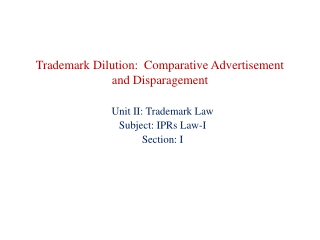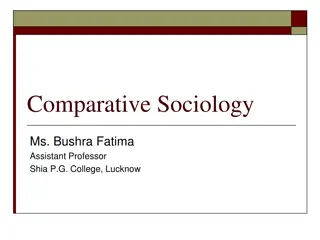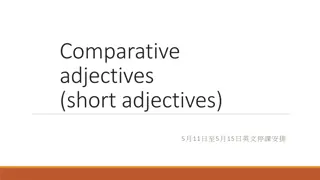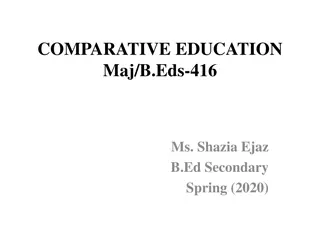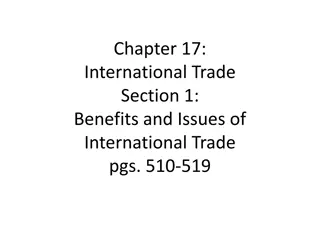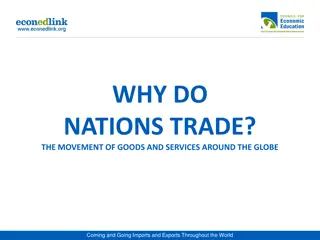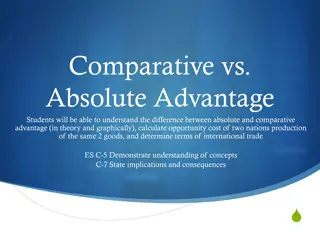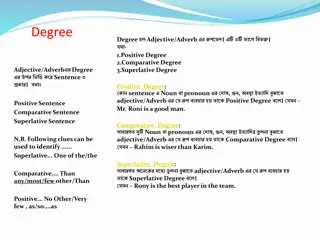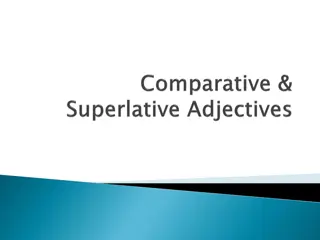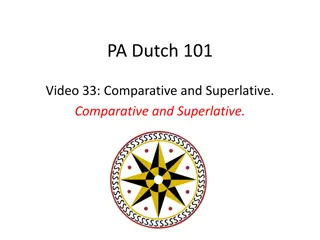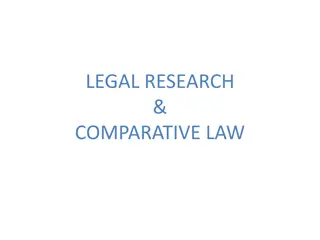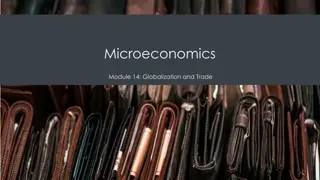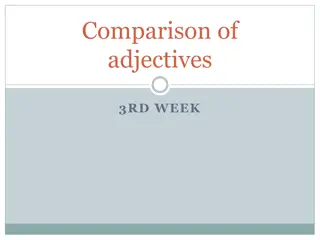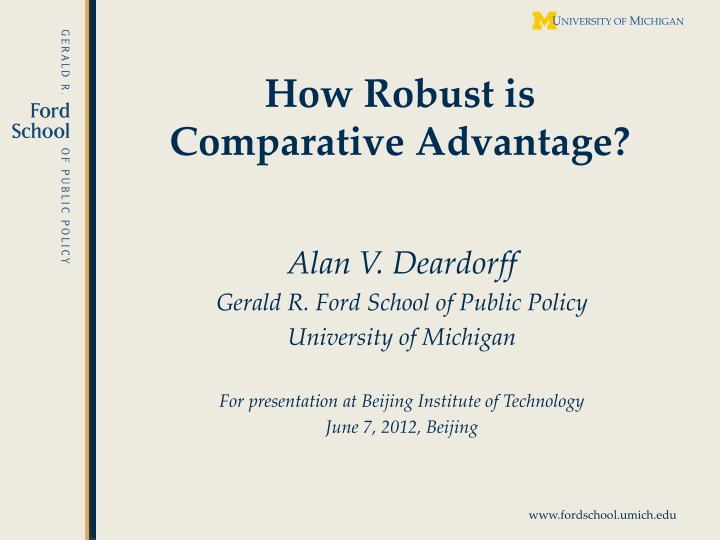
Robustness of Comparative Advantage Theory
Explore the robustness of Comparative Advantage (CA) theory beyond Ricardo's basic framework, discussing its implications and limitations. CA remains a fundamental concept despite weak generalizations, offering gains from trade by specializing in goods of comparative advantage.
Download Presentation

Please find below an Image/Link to download the presentation.
The content on the website is provided AS IS for your information and personal use only. It may not be sold, licensed, or shared on other websites without obtaining consent from the author. If you encounter any issues during the download, it is possible that the publisher has removed the file from their server.
You are allowed to download the files provided on this website for personal or commercial use, subject to the condition that they are used lawfully. All files are the property of their respective owners.
The content on the website is provided AS IS for your information and personal use only. It may not be sold, licensed, or shared on other websites without obtaining consent from the author.
E N D
Presentation Transcript
How Robust is Comparative Advantage? Alan V. Deardorff Gerald R. Ford School of Public Policy University of Michigan For presentation at Beijing Institute of Technology June 7, 2012, Beijing www.fordschool.umich.edu
The Issue How well does the concept of Comparative Advantage (CA) work beyond the simple 2 2 framework in which Ricardo explained it? The answer depends, in part, on what you interpret CA to mean: If it refers to the gains from trade, then it is very robust If it is meant to predict trade in particular goods, then it generalizes poorly But weak generalizations are possible and robust. Overall, CA is a fundamental and valuable concept. 2 www.fordschool.umich.edu
The Source Alan V. Deardorff, How Robust is Comparative Advantage?, Review of International Economics 13(5), November 2005, pp. 1004-1016. Which draws on: Weak Links in the Chain of Comparative Advantage, Journal of International Economics 9 (1979):197 209. The General Validity of the Law of Comparative Advantage, Journal of Political Economy 88 (1980):941 57. Exploring the Limits of Comparative Advantage, Weltwirtschaftliches Archiv 130 (1994):1 19. 3 www.fordschool.umich.edu
CA in Ricardo The Ricardian Model: 2 goods: 2 countries: 1 factor: Constant costs: = labor needed to produce one unit of good g in country c Perfect competition 1, 2 1, 2 L = labor ag c 4 www.fordschool.umich.edu
CA in Ricardo A country has comparative advantage in the good whose relative labor cost (compared to the other good) is lower than in the other country. Country 1 has CA in good 1, relative to good 2, compared to country 2, if a1 a2 1 1<a1 2 2 (1) a2 Note, this is the same as a1 a1 1 2<a2 1 2 (1) a2 5 www.fordschool.umich.edu
CA in Ricardo 6 www.fordschool.umich.edu
CA in Ricardo Implications CA gives the opportunity for the world to increase output of everything by specializing Thus CA implies Gains from Trade These gains are obtained by each country specializing in... and exporting the good in which it has comparative advantage. 7 www.fordschool.umich.edu
CA in Ricardo Thus CA is about two things: The opportunity to Gain from Trade Prediction of the Pattern of Trade (who exports what) As we ll see Gain from Trade is very robust Pattern of Trade is much weaker 8 www.fordschool.umich.edu
CA in Haberler (1930) The Ricardian Model assumed only labor as a factor, and constant unit labor requirements (the a s). That is very restrictive, as more modern models drop both assumptions The Heckscher-Ohlin Model The Specific Factors Model These models are easily analyzed with a curved Production Possibility Frontier, together with Community Indifference Curves. 9 www.fordschool.umich.edu
CA in Haberler (1930) CA is still easily defined in terms opportunity cost, which is measured by relative autarky prices, : pg c A country has comparative advantage in the good whose autarky price, relative to the other good, is lower than in the other country. Country 1 has CA in good 1, relative to good 2, compared to country 2, if p1 p2 p2 1 1<p1 2 2 (1') 10 www.fordschool.umich.edu
CA in Haberler (1930) Autarky equilibrium: x2 p1 p2 x1 11 www.fordschool.umich.edu
CA in Haberler (1930) 12 www.fordschool.umich.edu
CA and Gains from Trade In Haberler s model, it is again true that If countries differ in relative autarky prices, there is both CA and Gain from Trade In order to gain from trade, they must export the good in which they have CA Note that trading in accord with CA is necessary, but not sufficient for gain from trade. 13 www.fordschool.umich.edu
CA and Gains from Trade CA is necessary for Gain from Trade: 14 www.fordschool.umich.edu
CA and Gains from Trade It is not sufficient: 15 www.fordschool.umich.edu
Strong Generalizations of CA With many (C) countries and only 2 goods: Rank the countries in order of : p1 p2 p2 c p1 p2 c 1 1<p1 2 2<...<p1 C C p2 Then all countries that export good 1 will lie to the left of all that export good 2 p1 p2 p2 p2 1 1<...<p1 c1 c1<p1 c2 c2...<p1 C C p2 Export 1 Export 2 Location of the line (c1, c2) depends on country sizes. 16 www.fordschool.umich.edu
Strong Generalizations of CA With many (G) goods and only 2 countries, a similar chain of comparative advantage works, but only in the Ricardian Model: Rank the goods in order of relative labor requirements in the two countries: a1 a1 a2 aG 1 2<a2 1 2<...<aG 1 2 Then all goods that country 1 exports will lie to the left of all that it imports. This does not work with variable costs in Haberler s model, since costs can be interdependent. 17 www.fordschool.umich.edu
Strong Generalizations of CA Even these chain propositions fail, in both Ricardian and Haberler models, if there are both Intermediate inputs Barriers to trade This is shown in Deardorff (1979), in the context of the Heckscher-Ohlin trade model. It can be illustrated also in a Ricardian Model with intermediate inputs, as follows: 18 www.fordschool.umich.edu
Impossibility of Strong CA Example: Assume 4 goods: Steel, input to Autos Wool, input to Cloth (1 unit 1 unit, each) 2 countries of equal size Demands for autos and cloth: equal expenditure shares www.fordschool.umich.edu
Goods Direct unit labor requirements Country 1 Country 2 W A C S Wool 1 4 Autos 2 3 Cloth 3 2 Steel 4 1 Final Goods A Autos 2+4=6 3+1=4 Direct+Indirect unit labor requirements Country 1 Country 2 C Cloth 3+1=4 2+4=6 www.fordschool.umich.edu
If all goods are traded without cost Goods Direct unit labor requirements Country 1 Country 2 W A C S Wool 1 4 Autos 2 3 Cloth 3 2 Steel 4 1 Results: Country 1 exports autos (and wool) Country 2 exports cloth (and steel) www.fordschool.umich.edu
If only final goods are traded Final Goods A Autos 2+4=6 3+1=4 Direct+Indirect unit labor requirements C Cloth 3+1=4 2+4=6 Country 1 Country 2 Results: Country 1 exports cloth Country 2 exports autos www.fordschool.umich.edu
Impossibility of Strong CA Results of Example: Summary If all goods are traded without cost Country 1 exports autos Country 2 exports cloth If inputs, steel and wool, are not traded Country 1 exports cloth Country 2 exports autos Thus, trade in autos and cloth reverse if steel and wool are not traded. www.fordschool.umich.edu
Impossibility of Strong CA Implication: Any definition of CA that predicts trade correctly in one case will be wrong in the other. (Unless the definition itself takes account of trade costs. That s something I won t address here, though I do in another place.) www.fordschool.umich.edu
Weak Generalizations of CA What does hold in general with any numbers of goods and countries, as well as many other relaxed assumptions is that CA predicts the Pattern of Trade On Average. Specifically, letting be net exports of good g by country c (so that for an import), then Tg c Tg c<0 Theorem: g pcTc= <0 (6) cTg c pg This says (since the vector Tc has positive elements for exports and negative for imports) that autarky prices of exports are lower than of imports. 25 www.fordschool.umich.edu
Weak Generalizations of CA g pcTc= <0 (6) cTg c pg { }, c=max Tg More formally, letting { c,0 Xg }, & Xc= Mc= c=max -Tg c,0 wXg c Mg pg g c wXg Xc c c wMg Mc c pg pg pg pg pg pg g g < (7) w w That is, the country s trade-weighted autarky prices relative to world prices, pw, are lower for its exports than for its imports. 26 www.fordschool.umich.edu
Weak Generalizations of CA g pcTc= <0 (6) cTg c pg Other interpretations involve correlations, stated as Corollaries of (6) in Deardorff (1980). Corollary 1: The simplest and similar to (7) is a negative correlation between a country s autarky prices relative to the world and the value at world prices of its trade: <0 c w, pg pg pg wTg c cor 27 www.fordschool.umich.edu
Weak Generalizations of CA g pcTc= <0 (6) cTg c pg Most broadly, autarky prices and trade are negatively correlated across all goods and countries: Corollary 4: Let be a CG length vector of all P pg c, c=1,...,C; g=1,...,G and E be a vector of the c, c=1,...,C; g=1,...,G, Tg same length of all then cor P,E ( )<0 28 www.fordschool.umich.edu
Weak Generalizations of CA g pcTc= <0 (6) cTg c pg Proof of Theorem (omitting country superscript): Notation: T = Q C, where Q and C are vectors of output and consumption with trade, and are vectors of output and consumption in autarky . First the Gains from Trade: pwT = pw(Q-C)=0 by balanced trade pwQ pwQ=pwC by producer maximization Q=C \pwC pwC so that C is revealed prefered to C 29 www.fordschool.umich.edu
Weak Generalizations of CA Proof (continued): pwC pwC pC > pC by Weak Axiom of Revealed Preference (WARP) pQ pQ by producer maximization, again \pT = p(Q-C)< p(Q-C)=0 Q.E.D. 30 www.fordschool.umich.edu
Weak Generalizations of CA Result permits: (I used more assumptions for the simple proof above, but the paper allows much greater generality.) Multiple goods and countries (also, implicitly, multiple factors of production) Tariffs and other artificial trade costs Transport costs and other real trade costs Intermediate inputs Note that these assumptions are enough to include the example earlier, where CA failed to predict trade of cars and cloth, with inputs of steel and wool 31 www.fordschool.umich.edu
Goods Direct unit labor requirements Country 1 Country 2 W A C S Wool 1 4 Autos 2 3 Cloth 3 2 Steel 4 1 Assume wages = $1 in both W A C S Autarky prices Country 1 Country 2 1 4 6 4 4 6 4 1 www.fordschool.umich.edu
Assume Labor endowments = 120 in both Consumers demand equal units of cloth and autos Without trade in inputs Country 1 exports 15 cloth and imports 15 cars p1T1= 4(15)-6(15)=-30<0 With trade in inputs Country 1 exports 20 wool and 20 autos Imports 20 steel and 20 cloth p1T1=1(20)+6(20)-4(20)-4(20)=-20<0 Wool Autos Steel CLoth 33 www.fordschool.umich.edu
Weak Generalizations of CA Result also permits: Arbitrary preferences of consumers Services, traded or not Dated goods Differentiated goods Unbalanced trade Lumpy countries 34 www.fordschool.umich.edu
Weak Generalizations of CA Result does not permit: Domestic distortions Increasing returns to scale Note though that while these can interfere with the result if they vary across sectors or countries so as to undermine CA, they could also do the opposite, enhancing CA. Thus their presence suggests only that we are ignorant, not necessarily that we are wrong. 35 www.fordschool.umich.edu

